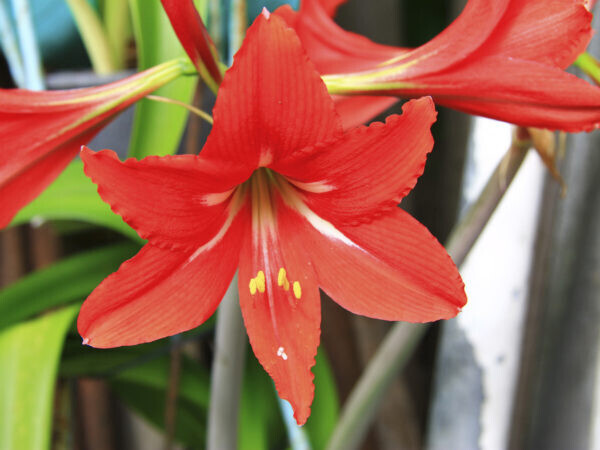The rhythms of my life are quite predictable. I wake up around the same time each morning. I get a paycheck every two weeks. Taxes are due same time next year. Then there is the pulsating traffic, dancing to the red and green and yellow lights. Coupons that expire. Water bills. Commercial television.

In a world where schedules rule, gardening has taught me to love unpredictability. The amaryllis bloom at Dr. Weil’s ranch is an annual ritual that I have grown to love because it is both predictable and surprising, as it happens at precisely approximately almost around the same time every year.
To photograph the amaryllis robs it of its soul and stuffs it in a small box. But to see it in the flesh, to see it living, you will understand why Dr. Weil and so many others find this flower to be one of the most captivating of them all.
Bulbs should be purchased by mail or at the local nursery. Several mail-order companies send potted amaryllis for holiday gifts. Bare-root bulbs should be ordered no later than August. Bulbs are sold already potted or bare-rooted at the nursery. Potted bulbs should be purchased before the flower has opened. Bare-root bulbs should be substantial in size, symmetrical and free from any apparent mold. Though small bulbs will flower, they will not generally have enough energy to recover from blooming. If you plan on keeping your bulbs for next year, bigger is better.
Bare-root bulbs should look relatively fresh with plump roots forming at the base. If they look dry or damaged, soak the bulb in tepid water overnight. We plant our bulbs in Black Gold potting soil, mixing in a small amount of Bulbs Alive! bulb fertilizer made by Gardens Alive!. The bulb should fit the pot rather snugly, with just an inch or two between the bulb and the pot. Be sure to cover any drain holes (still allowing for some drainage) with a piece of broken pot or a small stone. Two-thirds of the bulb should be beneath soil level and a third of it above.
After the bulb is planted, water it thoroughly. Place the container in a warm location. Keep the soil slightly moist. The first growth will be an unmistakable diamond of green growing between the inner layers of the bulb. When this appears, move the bulb to a sunny, warm location. Continue to keep the soil moist.
When in full bloom, the plant can be moved to lower light to prolong its flowering period. Turn the pot occasionally when in bloom to correct any leaning. Often, the heavy flowers born on the end of long, tubular stalks need to be staked. Each bulb will produce two flower stalks over-lapping in succession. The flowers are each about as big as a hand. Each stalk will have four flowers, so each plant will have eight blooms. Be sure to remove the spent and faded flowers (the droopy petals of the more vibrant colorings will stain skin and clothing). After the flowers are finished, cut the stalk off at the base.
At this point, the strap leaves will begin to emerge. These leaves will partially replenish the energy (stored in the bulb) that the massive flowers used. Supplemental feeding will be necessary and should continue through the warm growing season. To get your amaryllis to bloom again the following season, you will need to give it a dormant period. At Dr. Weil’s home we coincide our dormant period with the beginning of the cool weather in October and November. The bulbs should be kept nearly dry and stored in a cooler, shadier location. The leaves will die back and should be removed. After six to eight weeks of dormancy, water and fertilizing should begin again. Six to eight weeks after feeding and watering has resumed, your bulb should flower.
Dr. Weil says that the amaryllis blooms like slow fireworks. I say, if the gloom of December weather and the doom of the impending holidays hang over you, buy yourself and everyone you know an amaryllis. It’s a great way to slow it all down. Invite the rhythms of nature back into your home. Taking a little time to check on the progress of your amaryllis will help you pause during the hectic holidays. You know, that brief period of time that begins precisely after you swallow the last bite of your Thanksgiving meal and ends at exactly right before stores close on December 24. Your amaryllis will be there for you through it all.
Instead of having to return your gift, give the gift that returns year after year.